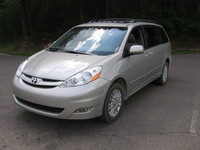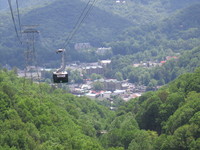2007 Toyota Sienna XLE AWD Review
A Real Family Car in a Real Family Place – The Smoky Mountains By Steve Purdy TheAutoChallel.com Detroit Bureau
This week’s road trip is to the Great Smoky Mountains, an easy 9-hour drive from our Southern Michigan home. We’ll be staying at Sunterra’s Bent Creek Resort, along Highway 321 about 11 miles northeast of Gatlinburg right at the edge of the mountains. These condos overlook an older, slightly neglected Gary Player-designed golf course that follows a rocky, narrow creek.

The good folks at Toyota have loaned us a new Sienna minivan for the trip. How appropriate. The Smokies and surrounding touristy towns are among the most popular travel areas for families and this Sienna is one of the most popular family vehicles. Sure sport-utilities have taken over much of the minivan market but Toyota still sells close to 130,000 of these a year - year after year.

Along with competing vehicles from Honda, Chrysler, Nissan, Hyundai and most of the others this minivan market is rife with great products and it accounts for big enough numbers that most manufacturers want to be in that market. So what if they’re not particularly sexy, trendy or cool. They are all handy, functional and full of innovation. Our Sienna, I see, has 10 cup holders and four bottle holders, cubbies and storage places galore, and even a little pop-down distortion mirror in the headliner so the driver can keep an eye on the miscreants in the rear seats. The third row of seats fold flat into the floor for better cargo space. And a third seat can be had in the second row that slides forward so that a little one can be safely strapped in and still be within easy reach of Mom or Pop in the front passenger seat.
We are feeling wasteful as we load up. We have the seven-passenger seating arrangement in our test car. An 8-seat version is available. This Sienna has 43.6 cubic-feet of cargo space with all seats (three rows) in place, 94 cubic-feet with the third row folded and a phenomenal 149 cubic-feet with both rear rows folded. Our meager cargo is barely evident in the rear. We don’t even have a boat or ATV to use the 3,500-pound towing capacity. We would have no difficulty, I’m sure, traveling with two other couples or a gaggle of kids and all their stuff in this generous space. That, of course, is one of the charms of a minivan – all that handy, useable space.
Minivans are generally based on car platforms and the Sienna is no exception. Built in Princeton, Indiana it is loosely based on the front-wheel-drive Camry, and it feels much the same. In this case it’s just my pretty blonde and me luxuriating in all that space. Last fall we took two of her brothers and their wives on a tour of the Pacific Northwest in a Dodge Grand Caravan so we have a good point of reference.
We both love the quiet and contemplative nature of a long drive so we usually don’t even use the radio or sound system on our road trips. In this case, however, we’ve decided to try out the JBL Synthesis premium sound system in the Sienna along with the XM Satellite radio. Magnificent sound came out as we skimmed the oldies stations. Ten speakers, including a dedicated center channel for imaging and specialized dual voice coil subwoofer for deep smooth base response fill the Sienna with rich sound. An input jack for your MP3 player will let you listen to your own stuff, of course.
Arriving well before dusk we checked into our resort and quizzed the staff to find out about some of the places we have not explored around the Smoky Mountain National Park on previous trips. They came up with plenty to keep us busy this week. While looking at the map I ask about the wiggly line crossing the northeast edge of the park toward a place called Cataloochee. She said, “Oh, you don’t want to go that way. The pavement only goes for about 11 miles and it’ll take forever to get through the park that way. You’ll want to go around to the freeway and back in from the northeast.”
I don’t think so. We’re shunpikers, after all. We love the back roads and our goal is always to find our way to the end of every road we explore.
We started out early the next day with a hearty breakfast of blueberry pancakes and eggs at the recommended local joint, Big Wally’s, a little café next to the Texaco station out here in the boondocks. This is obviously where the locals eat to avoid the tourists. Our white-haired waitress, a country-gal for sure, told us Big Wally started the place but now is living in Germany working as a golf instructor. Not the story we expected.
With a quarter tank of fuel we started into narrow, twisty Highway 32 southbound. Looks like the road to Cataloochee is about 50 miles so that ought to be enough gas to get there. Sure enough, the pavement ended after about a dozen miles. Barely wide enough for two cars to pass, the gravel and occasionally rocky road wound on and on through a nearly constant tunnel of trees. The rhododendrons were mostly spent with little else flowering except the pointy-topped roadside wild astilbe. Occasionally we’d get a peek at the rich green vistas of foothills on the left and mountains on the right. The fuel gauge slipped lower and lower. The navigation screen showed miles and miles to go. Are we going to make it?
Suspension and steering are good considering the vehicle’s format. With conventional McPherson struts and gas-filled shocks in front and torsion beam with coil springs and gas-filled shocks in the rear we had a comfortable, controlled ride both on the freeway at speed and on these windy, bumpy back roads. We even got to test the exceptionally good – 36.8-foot – turning circle a couple of times. The unitized body is plenty stiff and Toyota says it has an anti-vibration subframe as well. The power rack-and-pinion steering, while light and without a lot of feedback, is precise and easy to manage on these challenging roads.
With the fuel gauge bumping on, and sliding a tad below, the empty mark we finally made it to Cataloochee, a lovely natural area within the park where wild turkeys strolled through the tall grass along the forest edge. We expected a little town where we might find some gas. Wrong! It’s just another accessible area of the Great Smoky Mountain National Park. We didn’t look at the map closely enough. Elk, they say, often graze these meadows but we saw none, probably because we were focused on the gas gauge; and perhaps because of our discovery that the road dead ended there. Oh oh! The ranger told us the nearest gas was past Cove Creek, about 15 miles back out toward I-40.
So back we went to where we saw the sign indicating that I-40 lay 7-miles to the right. We started to calculate. My pretty blonde looked in the manual and found that we have a 21-gallon tank. We filled last when the gauge was a peg’s width or two above empty and it took nearly 17 gallons. OK, maybe we’ll make it. Some fool was trying to maneuver a pickup with travel trailer through the tight curves but we managed to get around him and on to the little settlement of Cove Creek where the pavement began again. We found gas a few miles beyond just as the two-lane approached I-40. Bless those Toyota engineers for giving us a good margin of error.
We seem to be getting about 22-mpg. Not bad since the EPA estimates we should get between 18 and 23. A respectable 0.30 coefficient of drag helps that mileage on the highway but has little influence on the mountain twisties. The Sienna is powered by a 266-hp, 3.5-liter V6 engine generating 245 lb.-ft. of torque. Intelligent variable valve timing and plenty of other state-of-the-art engine technology combine to provide more horsepower than previous versions and just as good gas mileage. Mated to a 5-speed overdrive automatic transmission we seem to have all the power we need though we’re often bumping down a gear or two climbing and descending the mountains. While not equipped with a manual mode in the usual sense we can shift easily through the gears right down to low, and did so many times on the steep lanes all over the park.
 |
I’m not fond of this Toyota navigation system. We tried over and over to get it to accept the address of a B&B we wanted to check out. Twice we had the wrong region selected but had no way of knowing that. Once we had the right region we put in the address successfully but when we asked the system to guide us there it selected a different address without so much as a “pardon me.” And, when zooming out from the detailed close up view all the secondary roads went away at only a quarter-mile range. We did find the B&B, by the way, purely by accident while exploring the back roads. Yes, yes, I know, we should read the instructions on such a complex piece of equipment, but GM and Ford systems are intuitive and simple enough that they are easier to use. The German systems, on the other hand, are even more complex and less user-friendly.
 |
 |
The air became distinctly chilly at that elevation as the sun got lower in the sky. Only about a dozen of us were there to witness the drama of the sun turning from orange to red as it slowly moved into the clouds near the horizon fifty or more miles away. The sky above changed color as well in a painterly fashion and the mountain ridges for probably eighty miles around silhouetted against each other in changing shades of green, then sage, then gray, then dusk. If you’ve seen the classic artist’s depiction of the Smoky Mountains you’ve probably seen how the silhouettes of the ridges interplay with one another. Magnificant!
 |
Our test vehicle is the XLE AWD version of the Sienna with a base price of $33,330. The sticker shows just two options on ours: one titled Carpet Floor Mat/Door Sill Protector at $214 and one called XLE Package #9 which includes leather trim seats, seat heaters in front, side window shades, DVD-based navigation system with touch screen, voice recognition and back-up camera, JBL premium audio, DVD rear entertainment system with wireless headphones, two 115-volt power outlets, power moon roof and rear intuitive parking assist. That package lists at $6,800. All that plus the $645 delivery charge comes out to just about 41-grand.
The most basic of the four Siennas, the CE, starts at $24,155. The LE begins at $25,680. The luxed-up XLE is $30,125. And, the top-of-the-line Limited starts at $35,465. All-wheel-drive can be had with all but the CE for about three-grand extra.
Nearly all the safety equipment comes standard on all versions of the Sienna - lots of airbags, 3-point seat belts with pretensioners at all seating positions, and anti-lock disc brakes. Toyota’s Vehicle Stability Control, anti-theft system, engine immobilization and intuitive parking assist are optional. Speaking of safety, the Sienna has earned NHTSA’s five-star rating for front and side impact crashworthiness.
So, when will there be a hybrid Sienna? After all, Toyota offers one in other markets and they are, of course, leading in the hybrid race here. They have clearly said there are no plans to offer a hybrid Sienna in the US. We’ll see if that remains true.
Sienna’s warranty is 36-months/36,000-miles comprehensive and 5-years/60,000-miles on the powertrain. This is minimal warranty coverage but with Toyota’s reputation for quality and dependability I guess they don’t really need to offer more than that.
One more traveler’s comment for all you old car guys and gals (meant in both meanings of the phrase –‘old-car’ guys and ‘old’ car-guys) reading this report: Gatlinburg and Pigeon Forge is a popular place for car events. Throughout the summer you’re likely to find some kind of major car or truck event here no mater when you come.
 |
 |
Finally, to cap off the week, we opted for some local entertainment and dinner at a little place called The Front Porch in Cosby just 20 miles northeast of Gatlinburg. Live bluegrass music and fresh Mexican food make this dark, low-ceilinged, out-of-the-way place, featured in many area newspapers and magazines as a well-kept secret, the ideal place for a relaxing evening. An intense thunder storm blew through just as we were ordering and the lights went out briefly. Our laid-back old waitress assured us that they cook with gas not electricity so we’d be OK. Looks like three, or maybe four, generations of a family operate the place. As we finished eating two fellows, one with a guitar and mashed-up cowboy hat, the other with a 5-string banjo, launched into an hour and a half of lively, energetic, down-home bluegrass music. A well-spent evening indeed.
I have an exploration in mind for our next trip to this beautiful mountain area. It has to do with an intriguing place name. You know how you become curious when you find on a map or a road sign the name of a place that just needs to be found. I’m thinking of places like Frying Pan Landing, North Carolina or Hell, Michigan or Intercourse, Pennsylvania. While exploring the back roads and perusing the maps here I have found a Boogerman Trail and a Boogerman Road. So there must be a village of Boogerman, wouldn’t you think? Gotta see that one.




